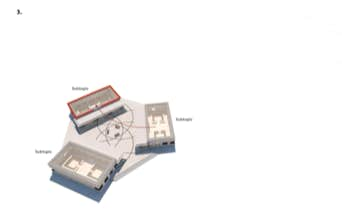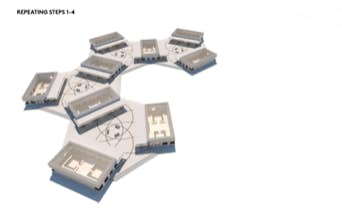2022/06
Majlis of the Future
A proposal for a dynamically generated network of meeting rooms in the Metaverse.
Over the past years the majlis expanded from a social practice into a space of cultural and intellectual exchange. The project »Majlis of the
Future« asks the question of how general principles of this tradition can support the development of ideas in the digital world and draw on the global community without losing its distinctive physical aspects. Following the question of how the Majlis of the Future can become a tool of engagement supporting important future priorities?, the project team developed a demonstrator on basis of Mozilla Hubs.
Mozilla Hubs demonstrator: http://www.mof.heritagelab.center
The Majlis of the Future is the result of the collaboration with Prof. Adina Hempel (Zayed University, UAE) and Prof. Zlatan Filipovic (American University of Sharjah, UAE) together with the students Jannik Mannefeld (Münster School of Design) and Luis Kirchlechner. The team was invited to the Smithsonian Folklife Festival 2022 (Washington D.C., USA) in June 2022 to present the project.
For this project, the principles behind historic majalis as places to foster exchange and discussion, and as a predecessor for decision making, are translated into the Metaverse. The resulting concept of a virtual majlis, explores such exchanges in the digital world, and is searching for connection and growth of ideas through the following steps:
- A majlis-module is being generated into the Metaverse representing a main-topic of a certain public or private interest. It is anticipated that those main-topics will be generated through AI systems, and that community members that interested in entering certain topic areas, will be enabled to get access.
- A centric platform becomes the entry point to three surrounding areas – three „houses“, called Majlis. Every Majlis houses corresponding subtopics. Animated text stripes integrated into the floor – keywords that are generated live through speech to text analysis in each Majlis section – give an orientation of the contents currently being discussed in each room. The moving textual information give orientation and lead the visitor inside.
- Visitors can either actively participate into discussions or be silent observers. They can freely move between the three areas.
- Once leaving a house through the opposite sided exit door, a new module (see 1) is adhoc being generated from the topics being discussed. Once generated, each module remains as a network node in the Metaverse and becomes part of an ever growing and interrelated network.
The below slides visualise the above described sequence:
Behavior and Protocol in the Majlis of the Future
Building Elements of the Majlis of the Future
With the goal to allow real world interactions with a focus on orientation and architectural structures, specific elements from traditional Emirati houses are manifested into the developed virtual architecture:



Step 1: Login – Invitation
Similar to most physical majalis one would have to be aware of the time and place and would need to be welcomed into the majlis itself. In the digital world, the login information acts as the invite into the majlis, followed by the selection of an avatar, which is comparable with getting ready and dressed appropriately for the gathering, before officially entering the Majlis of the Future.
Step 2: Exchange – Participation
Guest in the majlis can engage in the conversations and partake in the various discussions.
Step 3: Networked Community
The digital world allows a visitor to remain in the realm of conversation and unlike the physical world, where one would need to exit the majlis, here the visitor can continue to explore further topics and enter from one into the next majlis. This next majlis would run under a connected and automatically generated topic, hence continuing the conversation in more detail or a different aspect.
Step 4: Repeat



Entrance area – a dome
A featured area as a safe but open space to foster conversation and exchange.
Space of Exchange – the majlis
There is no formal host of the majlis, this is replaced by the topic of the space itself.
Seating area – the „future taqia“
Conversations are best held in a more intimate setting; hence the seating area allows for exchanges can be held with direct “seating” neighbors while one can listen in into the exchanges amongst other majlis visitors further away. With two seating areas the visitor can choose which area to “sit down” in and which audience to engage with.
Access to the MoF through VR-headsets.
Several avatars were developed during the project. Avatar design by Luis Kirchlechner and Jannik Mannefeld, Münster School of Design, University of Applied Sciences Münster.

Concept and demonstrator got presented at the Smithsionian Folklife Festival in June 2022. Vitiors were able to give feedback over a two weeks period.
Project partners:

























